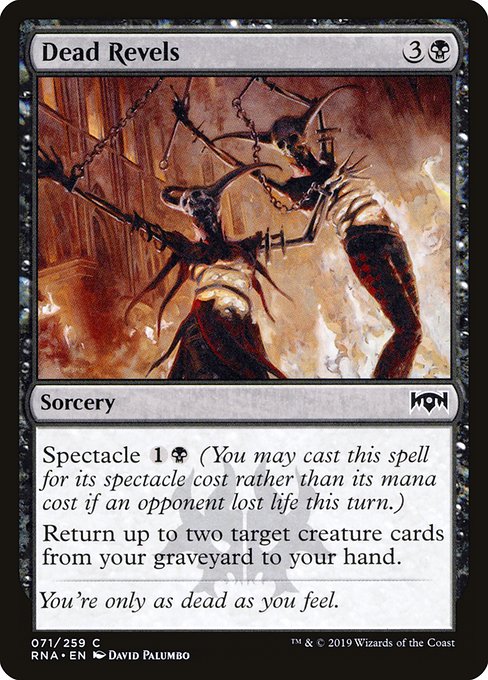
Image courtesy of Scryfall.com
Perspective Tricks in MTG Art Composition
Magic: The Gathering card art isn’t just pretty decoration—it’s a storytelling engine. When a frame, a focal point, and a vanishing point all cooperate, a single image can pull you into the scene just as effectively as an evocative card effect can pull you into a deck’s strategy. The artwork for Dead Revels, a Rakdos-flavored spell from Ravnica Allegiance, is a vivid case study in how perspective can echo a card’s gameplay and flavor. 🧙♂️🔥💎
Decoding the frame: perspective tricks at work
Palumbo’s Dead Revels uses a deliberately tilted, slightly low vantage to push the graveyard into your fold-out space. The viewer’s eye is drawn along a diagonal plane that travels from the foreground toward a shadowy centerpiece—the reveler between the tomb stones—creating depth that feels almost tactile. This is classic forced perspective: by placing elements of different sizes and sharply contrasting light, the artist makes the graveyard feel expansive and alive with menace, even as the spell returns creatures from the dead. The result is art that communicates the card’s theme of necromantic spectacle before you even read a line of text. 🎨
- Rough textures and crisp edges at the front anchor the scene and give the eye a starting point.
- The figure and spectral hints drift along a path that guides your gaze deeper into the composition.
- Distant silhouettes and architectural cues recede with cooler, dimmer tones, amplifying the sense of space.
- Stark highlights against deep shadows create a theatrical mood that mirrors the spell’s flash of power when spectacles are paid.
In many ways, these choices align with the Rakdos identity—chaotic, flamboyant, and just a touch dangerous. The art says: you’re about to witness a performance, and the stage is a cemetery. 🧟♂️⚔️
Spectacle, graveyard theatrics, and the card’s text
Dead Revels is a black sorcery with a strong tempo swing. Its base mana cost is {3}{B}, but it carries the unforgettable Spectacle mechanic: “Spectacle {1}{B} (You may cast this spell for its spectacle cost rather than its mana cost if an opponent lost life this turn.) Return up to two target creature cards from your graveyard to your hand.” This dual-cost concept is a clever design flourish: it rewards aggression and punishment at a moment you’ve already knocked your opponent down a notch. The art’s perspective mirrors that shift in tempo—an intimate, conspiratorial view of the graveyard that feels like a show about revival rather than a mere card effect. 🧙♀️
Dead Revels reads: “Spectacle {1}{B} (You may cast this spell for its spectacle cost rather than its mana cost if an opponent lost life this turn.) Return up to two target creature cards from your graveyard to your hand.”
The gameplay is straightforward but surprisingly potent in the right shell. In a Rakdos-based graveyard or sacrifice-focused deck, you can leverage the spectacle cost as an opportunistic second wind: if you’ve already pressured your foe, casting Dead Revels for {1}{B} can nets you up to two reclaim targets from the graveyard, effectively extending your aggressor’s life into a longer, more brutal assault. It’s the kind of multi-layered design that makes MTG fans grin—the text enables a clutch play, while the art reinforces the feeling of a dark theater awakening from the dust. 🔥
Flavor, lore, and the artist’s signature touch
Flavor text for Dead Revels—“You’re only as dead as you feel.”—fits the art’s mood perfectly. The phrase invites you to read the graveyard as a stage where fear, bravado, and revival collide. David Palumbo’s style—bold contrasts, angular composition, and a sense of kinetic tension—lends the glyphs of the Rakdos guild a sense of flamboyant danger. The artwork doesn’t just illustrate a line of rules text; it creates a moment you can inhabit when you cast the spell and imagine the two creatures stepping back into the fray from oblivion. This is the magic of MTG art: a single frame can carry story, strategy, and a bit of mischief all at once. 🎭🎲
From gallery to game table: collecting and strategic value
As a common rarity in Ravnica Allegiance, Dead Revels isn’t a chase card—yet its utility and the art’s appeal keep it relevant for casual collectors and players who savor the lore. The Scryfall data highlights a modest market footprint (nonfoil around USD 0.06, foil around USD 0.29). But beyond price, the card’s design questions—how you leverage spectacle, how you maximize graveyard recursion, and how you sync with a Rakdos “all-in” approach—are exactly the kind of deeper discussion that draws players into the multiverse. And while you’re building your mana curve around the deck’s core, the art’s perspective can inspire your own table talk about storytelling in card design. 🧙♂️💎
Artistic guidance for players and creators
If you’re a budding MTG artist or simply a fan who loves analyzing frames, Dead Revels offers a neat template: push your subject toward the viewer with a dynamic diagonal, echo the card’s mechanics with lighting that scorches the edges of power, and let the negative space behind fade into the gloom of the grave. Perspective tricks aren’t just cinematic devices—they’re tools that help players grasp tempo, risk, and narrative on a single glance. The art and rules text together whisper to you: in this world, revival isn’t free; it’s a spectacle carefully staged to tilt the balance of the game. ⚔️🎨
For those who want to add a touch of MTG mystique to everyday life, the cross-promotional link below offers a chance to pick up a sleek accessory while you let a few mind-bending card artworks loop in your head. And if your deck is feeling a little lighter, you can always lean on the card’s graveyard payoff as a reminder that resurrection can be strategic, stylish, and surprisingly timely. 🧙♂️🎲